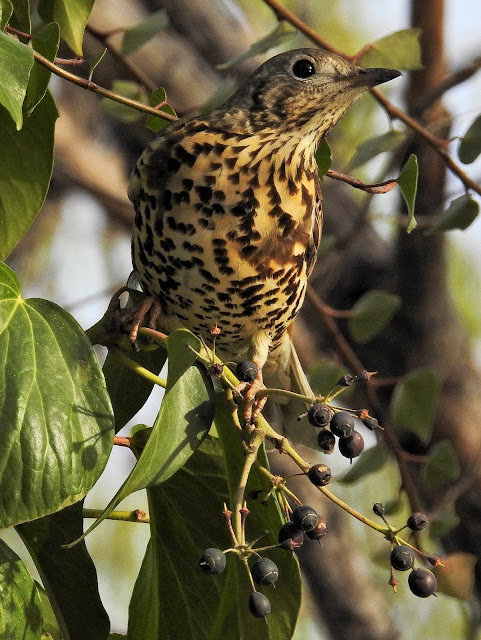The mistle thrush (Turdus viscivorus) is a bird common to much of Europe, temperate Asia and North Africa. It is a year-round resident in a large part of its range, but northern and eastern populations migrate south for the winter, often in small flocks. It is a large thrush with pale grey-brown upper parts, a greyish-white chin and throat, and black spots on its pale yellow and off-white under parts. The sexes are similar in plumage, and its three subspecies show only minimal differences. The male has a loud, far-carrying song which is delivered even in wet and windy weather, earning the bird the old name of stormcock. Historically, the name was also sometimes spelled "missel thrush".
Found in open woods, parks, hedges and cultivated land, the mistle thrush feeds on a wide variety of invertebrates, seeds and berries. Its preferred fruit include those of mistletoe, holly, rowan, and yew. Mistletoe is favoured where it is available, and this is reflected in the thrush's English and scientific names; the plant, a parasitic species, benefits from its seeds being excreted by the thrush onto branches where they can germinate. In winter, a mistle thrush will vigorously defend mistletoe clumps or other fruit-bearing trees as a food reserve for when times are hard, chasing off other thrushes and other fruit-eating birds like waxwings.
The open cup nest is built against a trunk or in a forked branch, and is fearlessly defended against potential predators, sometimes including humans or cats. The clutch, typically of three to five eggs, is incubated for 12–15 days, mainly by the female. The chicks fledge about 14–16 days after hatching. There are normally two broods. There was a range expansion in the 18th and early 19th centuries, and a small decline in recent decades, perhaps due to changes in agricultural practices. Given its numbers and large range, this thrush is classified by the International Union for Conservation of Nature as being of least concern.Mistle thrushes are found as individuals or pairs for much of the year, although families forage together in late summer, and groups may merge to form large flocks when food sources are plentiful. It is not uncommon for up to 50 thrushes to feed together at that time of year. They roost at night in trees or bushes, again typically as individuals or pairs, except in late summer or autumn when families may roost together.
The mistle thrush is quite terrestrial, hopping with its head held up and body erect; when excited, it will flick its wings and tail. The flight consists of undulating bounds interspersed with glides.Mistle thrushes feed mainly on invertebrates, fruit and berries. Animal prey include earthworms, insects and other arthropods, slugs and snails. Snails are sometimes smashed on a stone "anvil", a technique also used by the song thrush. The mistle thrush has been known to kill slowworms and the young of the song thrush, blackbird and dunnock.
Plant food includes the fruits and seeds of bushes and trees, mainly holly, yew, rowan, ivy and mistletoe, but also, for example, blackberry, cotoneaster, crab apple, cherry, elder, hawthorn, olive, sea-buckthorn, and rose. It may eat the flowers and shoots of grasses and other plants, and will take fallen apples and plums. It forages within its breeding habitat and in open fields, sometimes sharing these feeding areas with redwings, fieldfares, and ring ouzels.
Young birds are initially mainly fed on invertebrates, often collected from low foliage or under bushes rather than in the grassland preferred by the adults. Adults will roam up to 1 km (approximately 1,100 yards) from the nest on pasture or ploughed land. After fledging the young may accompany their parents until the onset of winter. Individuals or pairs will defend one or more fruit-bearing trees throughout the winter, with preference shown for trees which host mistletoe, the parasitic plant from which the bird derives its name. Where mistletoe is not present, holly is the most common tree chosen.[30] Although the thrush normally feeds on the ground and from low bushes, the defence of this resource conserves fruit for later in the season when other food items become scarce. The trees are defended against other thrushes as well as birds such as the bullfinch and great spotted woodpecker. In milder winters with an abundance of fruit, however, this strategy is less used and thrushes can be observed foraging in flocks. Conversely, in hard winters, the defender may be overwhelmed by large flocks of fieldfares, redwings or Bohemian waxwings.




%2021.jpg)